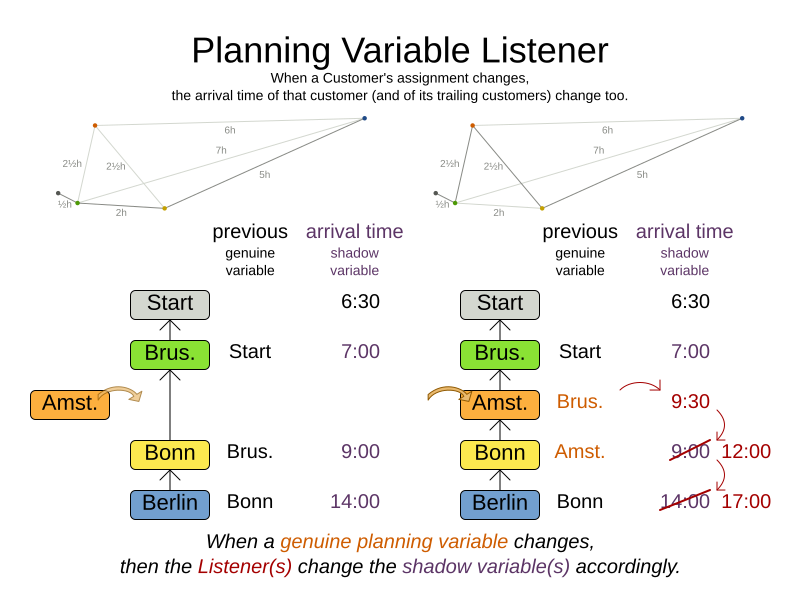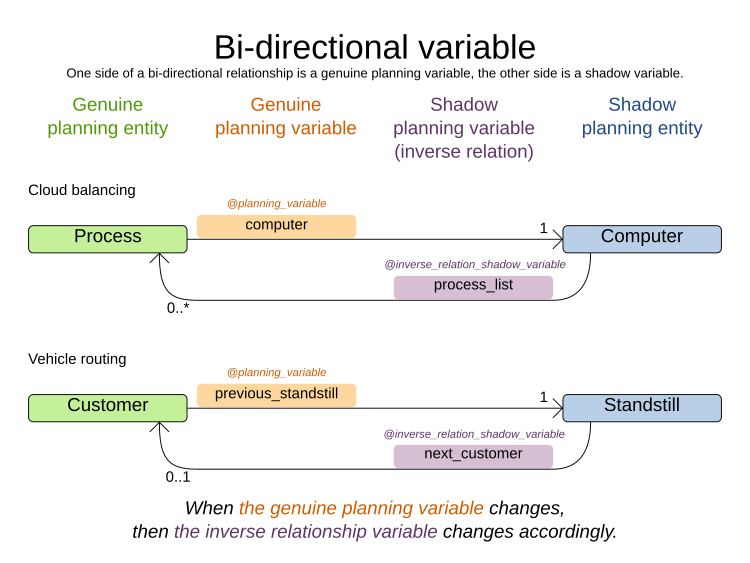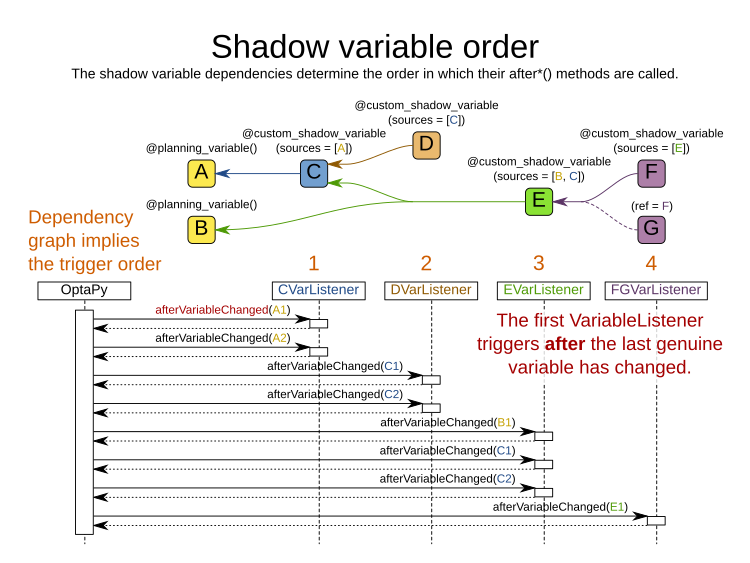Shadow variable
1. Introduction
A shadow variable is a planning variable whose correct value can be deduced from the state of the genuine planning variables. Even though such a variable violates the principle of normalization by definition, in some use cases it can be very practical to use a shadow variable, especially to express the constraints more naturally. For example in vehicle routing with time windows: the arrival time at a customer for a vehicle can be calculated based on the previously visited customers of that vehicle (and the known travel times between two locations).

When the customers for a vehicle change, the arrival time for each customer is automatically adjusted.
From a score calculation perspective, a shadow variable is like any other planning variable. From an optimization perspective, OptaPy effectively only optimizes the genuine variables (and mostly ignores the shadow variables): it just assures that when a genuine variable changes, any dependent shadow variables are changed accordingly.
|
Any class that has at least one shadow variable, is a planning entity class (even if it has no genuine planning variables).
That class must be defined in the solver configuration and be decorated with A genuine planning entity class has at least one genuine planning variable, but can have shadow variables too. A shadow planning entity class has no genuine planning variables and at least one shadow planning variable. |
There are several built-in shadow variables:
2. Bi-directional variable (inverse relation shadow variable)
Two variables are bi-directional if their instances always point to each other (unless one side points to None and the other side does not exist).
So if A references B, then B references A.

For a non-chained planning variable, the bi-directional relationship must be a many-to-one relationship. To map a bi-directional relationship between two planning variables, annotate the source side (which is the genuine side) as a normal planning variable:
from optapy import planning_entity, planning_variable
@planning_entity
class CloudProcess:
@planning_variable(...)
def get_computer(self):
return self.computer
def set_computer(self, computer):
...And then annotate the other side (which is the shadow side) with a @inverse_relation_shadow_variable annotation on a list property:
from optapy import planning_entity, inverse_relation_shadow_variable
@planning_entity
class CloudComputer:
# ...
@inverse_relation_shadow_variable(source_variable_name = "computer")
def get_process_list(self):
return self.process_list
...Register this class as a planning entity,
otherwise OptaPy won’t detect it and the shadow variable won’t update.
The source_variable_name parameter is the name of the genuine planning variable on the return type of the getter
(so the name of the genuine planning variable on the other side).
|
The shadow property, which is a list, can never be |
For a chained planning variable, the bi-directional relationship is always a one-to-one relationship. In that case, the genuine side looks like this:
from optapy import planning_entity, planning_variable
from optapy.types import PlanningVariableGraphType
@planning_entity
class Customer:
@planning_variable(object, graph_type = PlanningVariableGraphType.CHAINED, ...)
def get_previous_standstill(self):
return self.previous_standstill
def set_previous_standstill(previous_standstill):
...|
|
And the shadow side looks like this:
from optapy import planning_entity, inverse_relation_shadow_variable
@planning_entity
class Standstill:
@inverse_relation_shadow_variable(Customer, source_variable_name = "previous_standstill")
def get_next_customer(self):
return self.next_customer
def set_next_customer(Customer nextCustomer):
...Register this class as a planning entity, otherwise OptaPy won’t detect it and the shadow variable won’t update.
|
The input planning problem of a |
3. Anchor shadow variable
An anchor shadow variable is the anchor of a chained variable.
Annotate the anchor property as a @anchor_shadow_variable annotation:
from optapy import planning_entity, anchor_shadow_variable
@planning_entity
class Customer:
# ...
@anchor_shadow_variable(Vehicle, source_variable_name = "previous_standstill")
def get_vehicle(self):
...
def set_vehicle(self, vehicle):
...This class should already be registered as a planning entity.
The source_variable_name property is the name of the chained variable on the same entity class.
4. Custom VariableListener
To update a shadow variable, OptaPy uses a VariableListener.
To define a custom shadow variable, write a custom VariableListener:
implement the interface and annotate it on the shadow variable that needs to change.
@planning_variable(...)
public Standstill getPreviousStandstill() {
return previousStandstill;
}
@custom_shadow_variable(variable_listener_class = VehicleUpdatingVariableListener,
sources = [planning_variable_reference(variable_name = "previous_standstill")])
def get_vehicle(self):
return self.vehicleRegister this class as a planning entity if it isn’t already. Otherwise OptaPy won’t detect it and the shadow variable won’t update.
The source’s variable_name is the (genuine or shadow) variable that triggers changes to this shadow variable.
If the source variable’s class is different than the shadow variable’s class,
also specify the entity_class in the planning_variable_reference annotation
and make sure the shadow variable’s class is registered as a planning entity.
Implement the VariableListener interface.
For example, the VehicleUpdatingVariableListener assures that every Customer in a chain has the same Vehicle, namely the chain’s anchor.
from optapy import variable_listener
@variable_listener
class VehicleUpdatingVariableListener:
def afterEntityAdded(self, score_director: ScoreDirector[VehicleRoutingSolution], customer: Customer):
self.update_vehicle(scoreDirector, customer)
def afterVariableChanged(self, score_director: ScoreDirector[VehicleRoutingSolution], customer: Customer)):
self.update_vehicle(scoreDirector, customer)
# ...
def update_vehicle(self, score_director: ScoreDirector[VehicleRoutingSolution], source_customer: Customer)):
previous_standstill = source_customer.previous_standstill
vehicle = None if previous_standstill is None else previous_standstill.vehicle
shadow_customer = source_customer
while (shadow_customer is not None and shadow_customer.vehicle is not vehicle):
scoreDirector.beforeVariableChanged(shadow_customer, "vehicle")
shadow_customer.vehicle = vehicle
scoreDirector.afterVariableChanged(shadow_customer, "vehicle")
shadow_customer = shadow_customer.next_customer|
A |
|
Any change of a shadow variable must be told to the |
If one VariableListener changes two shadow variables (because having two separate VariableListeners would be inefficient), then annotate only the first shadow variable with the variable_listener_class and let the other shadow variable(s) reference the first shadow variable:
@planning_variable(...)
def get_previous_standstill(self):
return self.previous_standstill
@custom_shadow_variable(variable_listener_class = TransportTimeAndCapacityUpdatingVariableListener,
sources = [planning_variable_reference(variable_name = "previous_standstill")])
def get_transport_time(self):
return self.transport_time
@custom_shadow_variable(variable_listener_ref = planning_variable_reference(variable_name = "transport_time"))
def get_capacity(self):
return self.capacityA shadow variable’s value (just like a genuine variable’s value)
isn’t planning cloned by the default solution cloner,
unless it can easily prove that it must be planning cloned (for example the property type is a planning entity class).
Specifically shadow variables of type list, set, or dict usually need to be planning cloned
to avoid corrupting the best solution when the working solution changes.
To planning clone a shadow variable, add @deep_planning_clone annotation:
@deep_planning_clone
@custom_shadow_variable(...)
def get_used_man_hours_per_day_map(self):
...5. VariableListener triggering order
All shadow variables are triggered by a VariableListener, regardless if it’s a built-in or a custom shadow variable.
The genuine and shadow variables form a graph, that determines the order in which the afterEntityAdded(), afterVariableChanged() and afterEntityRemoved() methods are called:

|
In the example above, D could have also been ordered after E (or F) because there is no direct or indirect dependency between D and E (or F). |
OptaPy guarantees that:
-
The first
VariableListener'safter*()methods trigger after the last genuine variable has changed. Therefore the genuine variables (A and B in the example above) are guaranteed to be in a consistent state across all its instances (with values A1, A2 and B1 in the example above) because the entireMovehas been applied. -
The second
VariableListener'safter*()methods trigger after the last first shadow variable has changed. Therefore the first shadow variable (C in the example above) are guaranteed to be in a consistent state across all its instances (with values C1 and C2 in the example above). And of course the genuine variables too. -
And so forth.
OptaPy does not guarantee the order in which the after*() methods are called for the sameVariableListener with different parameters (such as A1 and A2 in the example above), although they are likely to be in the order in which they were affected.
By default, OptaPy does not guarantee that the events are unique.
For example, if a shadow variable on an entity is changed twice in the same move (for example by two different genuine variables), then that will cause the same event twice on the VariableListeners that are listening to that original shadow variable.
To avoid dealing with that complexity, overwrite the method requiresUniqueEntityEvents() to receive unique events at the cost of a small performance penalty:
from optapy import variable_listener
@variable_listener
class StartTimeUpdatingVariableListener:
def requiresUniqueEntityEvents():
return True
...